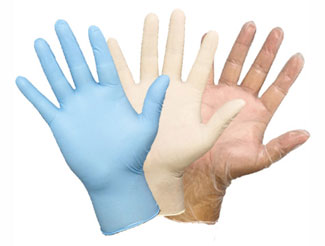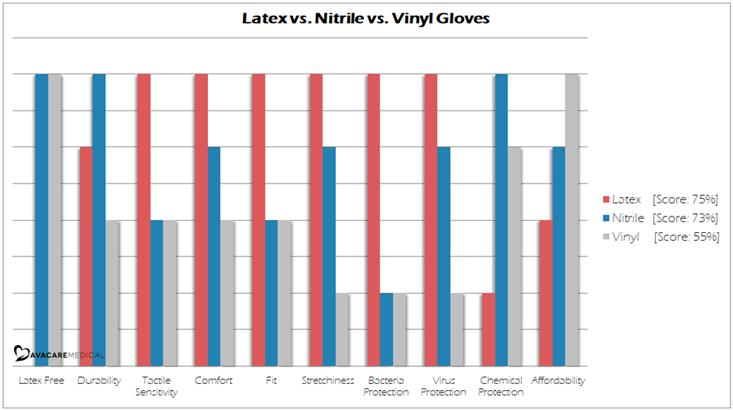Free shipping orders over $50
Disposable Gloves: How to Choose & Use.
WE ARE FULLY STOCKED WITH VINYL, NITRILE AND LATEX GLOVES. Shop now>>
A comprehensive guide on how to choose - and use - the best disposable gloves
Medical gloves help prevent cross-contamination between patients and their caregivers, as well as provide protection against dangerous chemicals and bacteria. For maximum protection, it is important to both choose the right gloves and use them properly.
How to Choose
When buying disposable gloves, there are many different options available to suit different needs. The level of protection, comfort, durability and more all vary between the types of gloves, which include latex gloves, nitrile gloves and vinyl gloves. With so many choices, the decision can get overwhelming, so let’s break it down and get an idea of why there are so many different types, to begin with. Once you understand this, the process of choosing gloves will be much easier.

Glove Types
Medical gloves are usually made from polymers such as latex, vinyl and nitrile, although you may find disposable gloves made of other materials, such as neoprene. The following is a quick comparison of nitrile vs. latex vs. vinyl gloves, including the differences in design and their unique benefits.
| Glove Type | Definition | Advantage | Protection Level |
|---|---|---|---|
| Latex Gloves | Made of natural rubber | Highest comfort, flexibility, fit and tactile sensitivity | Bacteria, viruses |
| Nitrile Gloves | Made of synthetic material | Stretchy, durable | Chemicals, viruses |
| Vinyl Gloves | Made of synthetic material, sometimes referred to as synthetic | Cost-efficient synthetic option, comfortable | Chemicals |
Latex Gloves vs. Latex-free Gloves
Latex gloves are often preferred by healthcare providers since they provide the best service when it comes to elasticity, comfort and fit. Surgeons in particular benefit from latex gloves since they are great for sensitive work, since they offer more precision with high tactile sensitivity.
Despite its advantages, latex gloves have become an issue for many health professionals due to the increasing rate of latex allergies, and many are choosing to go with non-latex glove options such as vinyl and nitrile gloves instead.
Vinyl gloves, which are made from PVC (polyvinyl chloride), are usually the cheapest latex-free gloves. However, many prefer to use higher-end gloves such as nitrile gloves. Nitrile gloves are often preferred since these non-latex gloves best resemble the stretchy feel of latex gloves, and are also highly durable and puncture resistant.
Another difference to consider when deciding between latex and latex-free gloves is the protection offered by each type of material. In general, latex gloves offer the best protection against bacteria and viruses, while synthetic gloves provide better chemical protection. Of the different types of latex-free gloves, nitrile gloves offer a higher degree of protection against viruses, besides the chemical protection they provide.

Glove Options
Now that we have a better understanding of the different materials of disposable gloves and their individual advantages, let’s explore the more specific options available. Each one of these options is intended to provide specific benefits for different uses. In order to choose the right glove type for the intended use, it’s important to understand what these advantages are.
| Glove Option | Explanation | Advantage |
|---|---|---|
| Powdered Gloves | Gloves that are powdered, often with cornstarch | Enhanced ease of donning due to powder |
| Powder-free Gloves | Gloves that have had powder coating removed | Reduced allergic reaction, cleaner to use |
| Chlorinated Gloves | Powder-free gloves treated with chlorine | Easy donning, particle-free to prevent allergic reactions |
| Non-chlorinated Gloves | Powder-free gloves with a coating of gel/silicone particles | Neutral color, odor-free, longer shelf life |
| Examination Gloves | Sterile or non-sterile medical grade gloves | Provides protection against blood or bodily fluid exposure |
| Surgical Gloves | Usually sterile, high quality medical grade gloves | Provides high-quality protection against blood or bodily fluid exposure |
| Chemo Gloves | Gloves that are tested and approved for use with chemotherapy drugs | Provides protection against chemotherapy drug exposure |
| Gloves with Aloe | Gloves with a coating of organic aloe | Moisturizes hands during use |
| Gloves with Oatmeal | Gloves with colloidal oatmeal | Prevents and protects dry skin |
Powdered Gloves vs. Powder-free Gloves
Powder-free gloves can be more expensive due to the process that needs to be done to remove the powder coating from the glove. However, gloves that are powder-free reduce the cause of allergies by lowering protein and chemical content. In addition, powder-free gloves are ‘cleaner’ to use than powdered gloves, since they don’t leave any residue on clothing or other surfaces.
Powdered gloves are usually lubricated with cornstarch, which makes them much easier to put on. Cornstarch coatings have replaced other powdering options such as lycopodium powder and talc because these other coating types have been found to irritate tissue. Nevertheless, even cornstarch can impede healing when coming into contact with tissues, so powder-free gloves are often preferred for surgeries and other sensitive procedures.
Chlorinated Gloves vs. Non-chlorinated Gloves
If you choose to use gloves that are powder-free, you’ll need to decide if you want to use chlorinated or non-chlorinated gloves.
For those who don’t want to use powdered gloves but want the advantages that come with that type of glove, chlorinated gloves are powder-free gloves that are treated with chlorine to make them easy to put on. These gloves are also particle free to avoid allergic reactions caused by soluble proteins. Chlorinated gloves are more commonly used than non-chlorinated gloves, although some prefer gloves that have a more neutral color and less of an odor. Another disadvantage of chlorinated gloves is their shorter shelf life: after about a year, chlorinated gloves become brittle, and when exposed to heat, these gloves may last even less than a year.
Non-chlorinated gloves, on the other hand, are closer in color to regular exam gloves and contain no chlorine odor. However, these gloves are not very popular since they are hard to put on, and are not particle free, since a ‘gel coat’ of tiny gel/silicone particles is added to make them slightly easier to don.
Examination Gloves vs. Surgical Gloves
Both surgical and exam gloves are medical-grade gloves for use during medical procedures.
Medical exam gloves can be used for patient examinations and blood tests. These gloves are also used as general purpose gloves for managing incontinence, everyday spills and messes in and around the home.
Surgical gloves are used by surgeons and operating room nurses. These disposable gloves must meet higher quality standards, and are usually sterile since they are used for surgical procedures. Surgical gloves offer better fit with more precise sizing, as well as higher tactile sensitivity.
Other Options
Chemo gloves are medical gloves that have been tested for use with chemotherapy drugs. When selecting chemo tested gloves, care must be taken to ensure that the gloves have been tested for the specific drugs being used.
Some options that care for the caregiver include gloves with aloe or oatmeal. Gloves with a heat-activated aloe coating soothe and moisturize hands during use. Hardworking hands can also benefit from the extra care provided by gloves that contain colloidal oatmeal skin protectants, which helps maintain the skin’s moisture barrier, thereby preventing and protecting dry skin.
⇒ For customers on a gluten-free diet who are concerned about the use of oatmeal gloves, click here.
In addition to the options listed above, there are other considerations when buying gloves. For example, different gloves are made with different finishes. Some gloves have a smooth finish, while others are partially or fully textured to provide better grip. Another consideration is the type of cuff the glove has. Most gloves are beaded for easier removal, and some gloves have an extended cuff for better coverage and protection.
How to Use
When used and removed properly, disposable gloves offer excellent protection against contamination. Follow the instructions below to get the most out of glove-wearing.
Step 1: Choose
Choose a glove that fits well and is designed for the intended use.
Step 2: Check
Check each glove for rips and punctures.
Step 3: Wash
Gloves should never replace proper hand-washing. Always wash and dry hands before putting on a pair of gloves.
Step 4: Wear
Put gloves on. While wearing disposable gloves, do not touch phones, doorknobs or the like.
Step 5: Remove
Never wash or reuse disposable gloves. In any of the following situations, be sure to remove gloves, wash and dry hands and don a fresh pair of gloves:
- ⇒ Between patients or tasks
- ⇒ When gloves become contaminated
- ⇒ When gloves become dirty
- ⇒ When gloves get torn
- ⇒ When gloves have been used for four consecutive hours
- ⇒ After sneezing, coughing, or touching one’s hair or face
When removing gloves, it is important to follow proper glove removal techniques such as the one shown below to avoid contamination from the outside of the gloves.
Tips
Double Gloving
Double-gloving, or wearing two layers of gloves, is known to provide significantly better protection against inner glove perforation, which lowers the risk of infection that can be caused by punctures or penetration.
At Work
If you own a nursing home, day care center or clinic, you can encourage employees to wear gloves consistently by providing a full range of sizes so all staff members can find a comfortable fit, as well as having enough dispensers throughout your facility so that a new pair of gloves is always accessible.
Do you have something to add? There’s nothing like personal experience! Let us know by calling or emailing us, and we’ll make sure to update our information.
At AvaCare Medical, we’re here to help you find the medical gloves that work for your needs. If you’re still confused about your options, give us a call today at 1-877-813-7799.
Disclaimer: No information presented on this website is medical advice or intended as a substitute for the advice of a physician. All information on this website concerning medical conditions is from publicly available sources.
Was this article helpful? Help others; pass it on!




